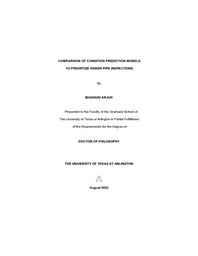| dc.description.abstract | Over time, wastewater collection systems deteriorate, necessitating ongoing adjustments and the development of asset management frameworks by utility proprietors to maintain the performance of their assets. Any asset management framework should emphasize the importance of asset inspection and condition assessment for system-efficient operation and maintenance. In the United States, closed-circuit television (CCTV) is the most common method for inspecting the interior of sewer pipelines. This procedure is expensive and time-consuming due to a city's extensive inventory of pipes. Due to the immense quantity of these pipes, every municipality can only inspect some sections of sanitary sewer pipes promptly.
Therefore, the main objective of the research is to develop models capable of predicting the future condition of wastewater pipelines. The results of the models can be used to evaluate the need for inspection, rehabilitation, and replacement of sanitary sewer pipes. This dissertation utilized sewer pipe inspection data from eleven utilities from four US regions, namely Southeast, Southcentral, Northeast and Midwest. This data set contains six independent variables, which includes pipe age, diameter, length, material, soil native type, and slope, and one dependent variable, sewer pipe condition rating, based on PACP scores ranging from 1 to 5. This study evaluated the oversampling technique to address the imbalanced dataset employing the SMOTE method. Several machine learning algorithms created prediction models, including Logistic Regressions, Decision trees, Random Forests, AdaBoost, Gradient Boosting, and XGBoost with default parameter, AdaBoost, Gradient Boosting trees and XGBoost with oversampled hyperparameter Tuned. The other objective of this dissertation is a comprehensive investigation of the effectiveness of various machine learning methods using a resampled dataset.
Numerous evaluation metrics-Accuracy, F1-score and area under the curve (AUC), were calculated to compare the efficacy of developed models. The XGBoost with hyperparameter Tuned model had the best performance scores for all the dataset under different US regions, while the multinomial logistic regression decision tree model had the lowest performance scores accuracy. It was determined that tree-based models performed better than other models and that hyperparameter tuning was more effective in boosting trees. | |


